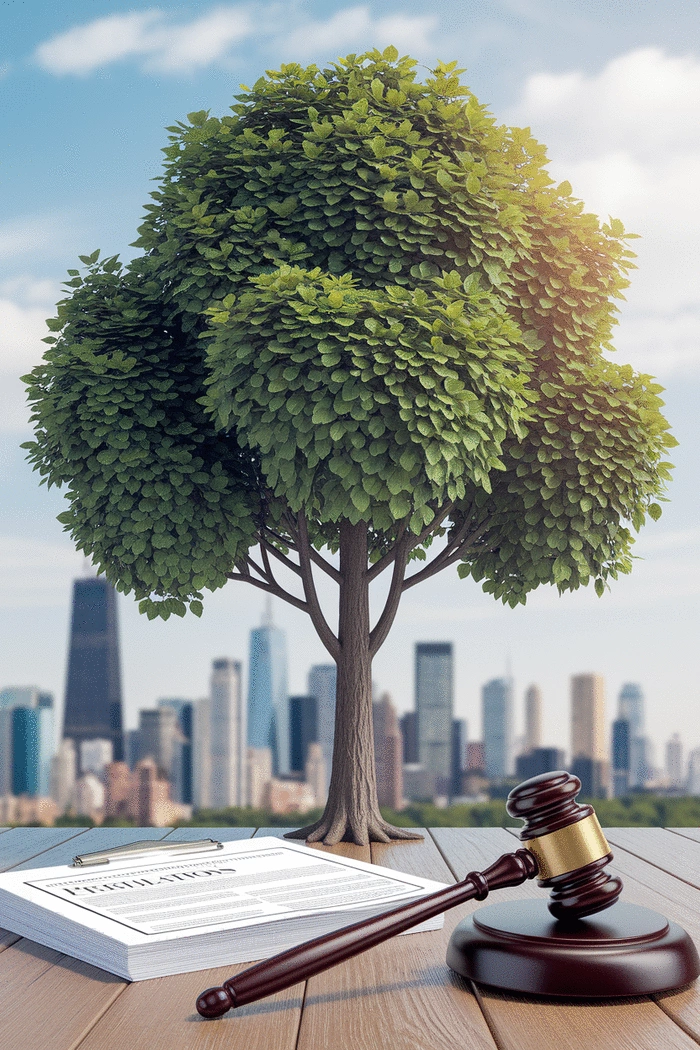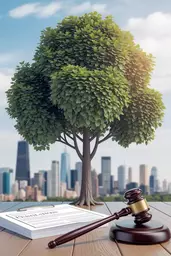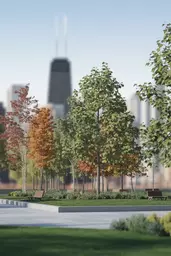Pacifica
- Stringent rules to protect coastal trees
- Focus on preserving native species
Subscribe to get expert tips and the latest insights on tree care and urban greening directly to your inbox.
Posted on: 2025-11-04
By: Keira Vallejo
In urban environments, trees are often the unsung heroes contributing to our well-being and the overall health of our communities. Understanding the laws that protect these natural assets is essential not only for compliance but also for fostering a richer, greener urban life. How can you become an advocate for trees in your area? Read on to discover the key insights on tree preservation laws and city regulations!
Exploring the unique tree preservation strategies adopted by Pacifica, Berkeley, and San Francisco showcases the diverse approaches to urban forestry.
In the bustling world of urban living, trees often play a vital role in our daily lives. Understanding the laws and regulations that protect these green giants is essential for any city dweller. After all, trees contribute immensely to our environment by improving air quality, providing shade, and enhancing the aesthetic appeal of our communities. So, let's dive into the fundamentals of tree preservation laws and their significance in urban areas!
Tree preservation laws are regulations designed to protect trees from removal or harm, especially in urban settings. These laws aim to maintain the ecological health of our cities by ensuring that trees are preserved during construction, development, and other activities. In many cases, these regulations also encourage planting and nurturing new trees to enhance urban greenery.
While the specifics can vary widely from one city to another, these laws often cover aspects like tree removal permits, maintenance requirements, and penalties for non-compliance. Understanding these laws helps residents actively participate in the preservation of their local environment!
Why should we care about tree preservation, you might ask? Well, trees are *not just pretty to look at*! They provide numerous benefits, such as:
By preserving trees, we create healthier urban environments that support both residents and wildlife. As someone who cares deeply about urban forestry, I believe that every tree we save contributes to a vibrant and sustainable cityscape!
The National Tree Protection Act provides a framework for tree protection at the federal level, promoting sustainable practices across the country. However, individual cities often have their own tree preservation ordinances that adapt these guidelines to local needs. These local laws can address specific challenges faced by urban trees, such as pests, disease, and climate considerations.
When you’re navigating your local regulations, it’s crucial to familiarize yourself with both the national guidelines and your city’s specific ordinances. This way, you can advocate for effective tree care in your community and ensure that the benefits of our leafy friends are preserved for generations to come! For more insights, explore the benefits of professional tree care.
Tree preservation laws are regulations designed to protect trees from removal or harm, especially in urban settings. They aim to maintain ecological health by preserving trees during construction, development, and other activities.
Tree preservation is crucial because trees improve air quality, reduce urban heat islands, enhance mental well-being, and support local wildlife, contributing to a healthier and more sustainable urban environment.
City councils create and enforce tree preservation laws, review tree removal requests, implement community environmental goals, and organize public meetings to engage citizens in the decision-making process.
The steps typically include checking local regulations, submitting a permit application with details on the tree's condition, attending a hearing if required, and receiving approval or denial from local authorities.
Arborists provide assessments of a tree's health, species, and significance, which are invaluable in supporting permit applications for both removal and preservation, streamlining the process and enhancing credibility with city officials.
Every city has its own unique approach to tree preservation. For instance:
By knowing the key ordinances in your city, you can better engage with local initiatives and advocate for tree health and preservation!
It’s fascinating to see how regulations vary even between neighboring cities! Some cities may prioritize protecting large, mature trees, while others focus on promoting tree planting and maintenance. This variability often reflects local values, community needs, and environmental goals.
As such, staying informed about your city’s specific approach empowers you to contribute positively to your local ecosystem. What’s your city doing to protect its urban canopy?
City councils play a pivotal role in creating and enforcing tree preservation laws. They are often responsible for reviewing tree removal requests and implementing policies that align with the community's environmental goals. Additionally, they may organize workshops and public meetings to discuss tree care, engaging citizens in the decision-making process.
Understanding how your city council operates can help you become an advocate for better tree policies. By attending meetings and providing feedback, you can influence how your community cares for its green spaces. Together, we can ensure that our urban trees receive the attention they deserve!
If you find yourself needing to remove a tree, it’s crucial to follow the proper steps to obtain a tree removal permit. Here are some general steps you may need to take:
Following these steps ensures that you comply with the law and helps protect the urban canopy!
In contrast, if you’re looking to protect a tree, you might need a tree preservation permit. Common requirements for this process can include:
Being prepared with the necessary information can make all the difference in ensuring that our treasured trees are protected!
Zoning regulations further influence tree preservation efforts by determining land use in different areas. These rules can affect where trees can be planted, how many can be removed, and what kinds of trees are appropriate for specific locations. Understanding zoning can help you navigate the complexities of tree protection and ensure compliance with local laws.
As a resident, being aware of these guidelines enhances your ability to advocate for urban forestry initiatives that benefit our communities and ecosystems!
Arborists are crucial in the tree preservation process. Their reports often serve as a foundation for permit applications, providing assessments of a tree’s health, species, and significance. This professional insight is invaluable in supporting the case for either removal or preservation.
Having a qualified arborist assist with your permit application can streamline the process and enhance your credibility with city officials. Trust me; it’s worth the investment!
Many cities designate certain trees as protected or heritage trees due to their age, size, or cultural significance. Criteria for such designations can include:
Recognizing these criteria helps everyone appreciate the value of our urban trees while ensuring that they receive the protection they deserve!
Conducting regular tree health assessments is fundamental to maintaining vibrant urban greenery. Best practices include:
Following these guidelines ensures that our trees remain healthy and continue to provide their many benefits to our urban environments!
During construction projects, it’s crucial to develop effective tree protection plans. These plans often include fencing regulations that delineate areas where trees must not be disturbed. By clearly marking these zones, we can minimize damage to root systems and preserve tree health during construction.
Working with contractors to ensure adherence to these plans can significantly impact the success of urban tree preservation efforts!
Monitoring procedures ensure compliance with tree protection regulations. These may involve periodic inspections by city officials to assess adherence to established plans. If violations occur, penalties can range from fines to restoration requirements, emphasizing the importance of following the rules.
Being aware of these monitoring processes helps everyone maintain responsibility for tree care in our communities. Let’s work to protect our urban forests together! As we aim to protect trees during construction, understanding the best practices for seasonal effects on urban tree roots is also essential.
Tree protection zones play a vital role in urban development. By designating areas where trees can thrive, we create safe havens amidst construction and growth. These zones not only help sustain tree health but also contribute to the overall beauty and functionality of urban spaces.
Understanding how to establish and maintain these zones is essential for any community committed to preserving its greenery. Together, we can make our urban landscapes healthier and more sustainable!
Sometimes, tree removal is unavoidable, especially when trees pose hazards to public safety. Criteria for evaluating whether a tree should be removed often include:
By understanding these criteria, we can make informed decisions about tree management in our cities!
For landmark trees, public hearings are typically required to ensure community input. These hearings allow residents to voice their opinions and concerns regarding the proposed removal. It’s a chance for community members to engage with local officials and advocate for their beloved trees!
Being prepared for such hearings can lead to meaningful discussions about tree preservation and its importance in urban life.
Public engagement is essential in the tree removal process. Effective strategies can include:
Fostering public engagement not only promotes transparency but also helps build a stronger community committed to preserving its urban canopy!
Technology is transforming tree preservation efforts! Tools like GIS mapping allow cities to monitor tree health and track compliance with preservation laws. These innovations enhance our ability to manage urban forests more effectively. To complement these efforts, understanding summer tree care tips for cities can further improve urban tree health.
Community advocacy is vital for advancing tree preservation. Local groups may organize campaigns, fundraise for tree planting initiatives, or collaborate with city officials to promote better policies. By joining forces, communities can amplify their voices and effect meaningful change!
Take a moment to consider how you might get involved in your community's tree advocacy efforts. Every action counts!
Urban greening initiatives not only enhance aesthetics but also promote biodiversity. By planting more trees and creating green spaces, we support various species and ecosystems that thrive in our cities. These efforts contribute to a healthier environment for all urban residents, including wildlife!
As we work together to promote these initiatives, remember that every tree planted is a step toward a greener, healthier urban ecosystem. Let’s keep the momentum going!
Did you know? Engaging with your local urban forestry program not only keeps you informed about tree preservation laws but also connects you with resources and community members who share your passion for green spaces. Participating in tree planting events or workshops can significantly enhance your knowledge and advocacy efforts!
Understanding tree preservation laws is crucial for anyone interested in urban forestry. These regulations aren't just legal jargon; they play an essential role in maintaining the health and sustainability of our urban landscapes. By becoming familiar with these local regulations, we can actively participate in keeping our city green and vibrant. At Urban Canopy Blog, we believe that knowledge empowers communities to protect their trees and, consequently, the environment.
Moreover, every city has its own unique tree ordinances. This means that what applies in one area might not be the same in another. Consequently, it's imperative to stay informed about your local tree preservation laws. Ensuring compliance not only nurtures our urban ecosystems but also prevents potential legal issues down the road.
Local regulations provide a framework for how trees are cared for and protected in our communities. By understanding these laws, we can better appreciate the reasons behind tree maintenance practices. Knowledge of regulations helps avoid unintentional violations, such as unauthorized tree removals or failing to secure the proper permits.
At Urban Canopy Blog, I often emphasize the significance of community participation. Engaging with local authorities regarding tree regulations can lead to beneficial outcomes for both residents and the environment. Plus, it helps build a sense of stewardship among community members!
So, how can you take action? The first step is to reach out to your local city council or arborist services to understand what specific regulations apply to your area. Becoming an advocate for tree preservation is not just about awareness; it involves proactive measures.
Every little bit counts! By staying informed and involved, we can collectively work towards a greener, healthier urban environment. Remember, your voice matters, and when we come together, we can make a significant impact on tree preservation in our cities!
Are you ready to jump into action? Engaging with local urban forestry programs is a fantastic way to promote tree preservation in your community. These programs often offer a wealth of resources and opportunities for involvement.
Finding the right contacts can facilitate your efforts in advocating for urban trees. Here are some points of contact to help you get started:
Reaching out to these organizations can help you understand how you can contribute to tree preservation efforts. Plus, it’s a great way to meet like-minded individuals who share your passion for urban greenery!
Participating in community tree programs is both rewarding and fun! Here are some ways to get involved:
Lastly, don’t forget to connect with nonprofit environmental organizations. These groups often lead the charge in advocacy for urban forestry and tree preservation. By collaborating with them, you can amplify your impact. Together, we can inspire others to take action and promote the benefits of trees in our urban spaces! If you're unsure where to begin, consider exploring resources that support your local trees.
Here is a quick recap of the important points discussed in the article:

 In urban environments, trees are often the unsung heroes contributing to our well-being and the over
In urban environments, trees are often the unsung heroes contributing to our well-being and the over
 Urban trees are essential to our cities, yet they face numerous threats from pests and diseases. Did
Urban trees are essential to our cities, yet they face numerous threats from pests and diseases. Did
 Did you know that urban tree diversity is crucial not just for aesthetics, but for the health of ent
Did you know that urban tree diversity is crucial not just for aesthetics, but for the health of ent